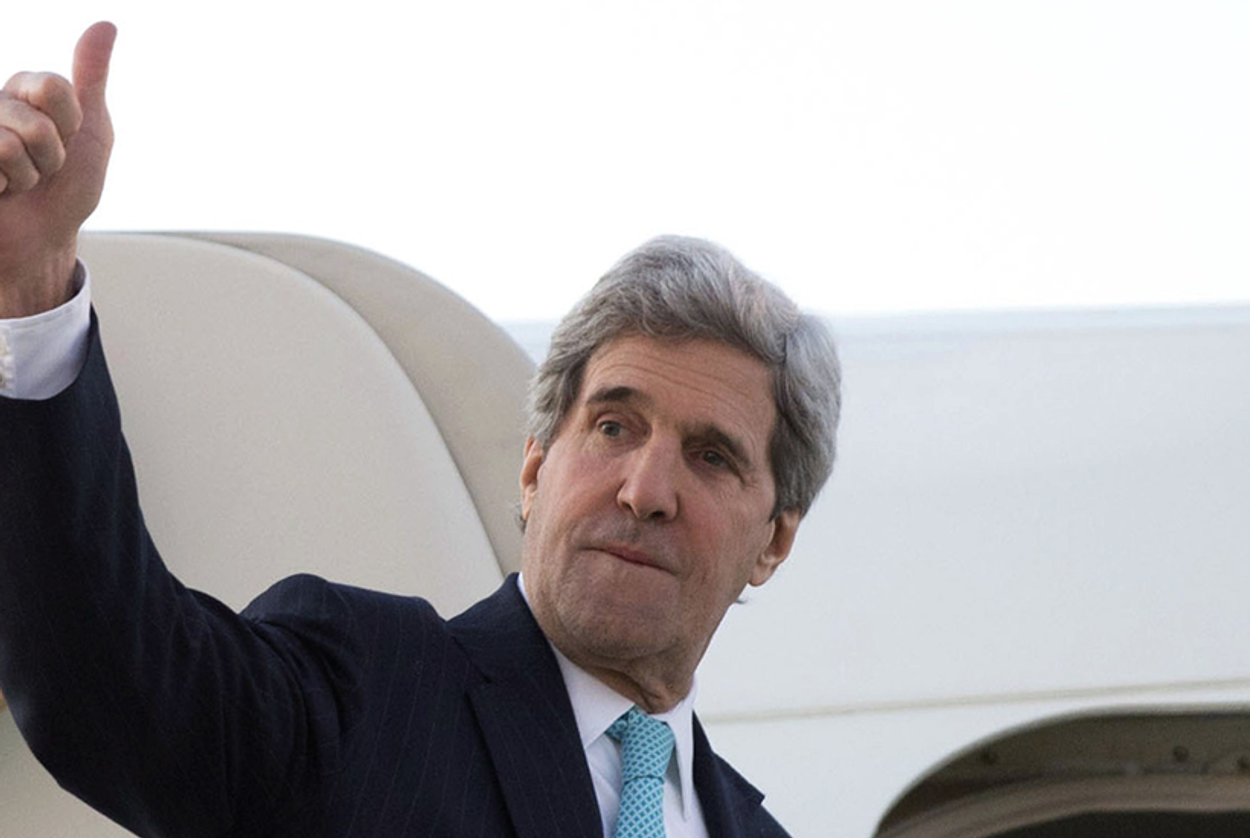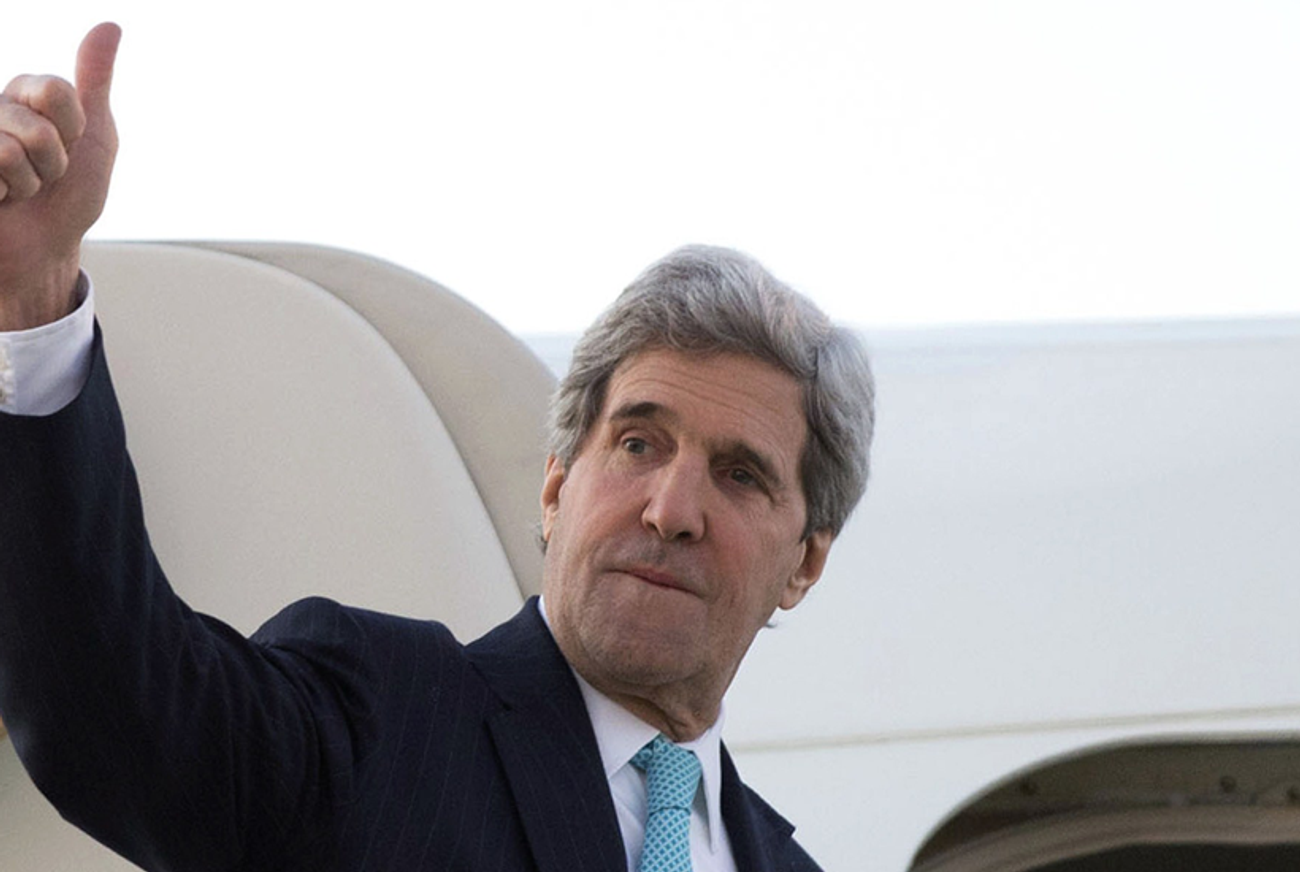America Is the Arsonist of the Middle East
John Kerry’s failed peace negotiations set off the spiral of violence between Israel and the Palestinians




Events are moving so quickly in the Middle East that it seems like whatever you are reading is already outdated. Yesterday, after Hamas fired dozens of rockets into Israel over the weekend, Israeli Air Force planes targeted the Gaza-based group and killed at least seven members. Hamas’ actions follow the murder of a 16-year-old Arab Israeli, who was killed by soccer thugs in an alleged act of retribution for the abduction and murder of three Jewish Israeli teenagers, whose bodies were found last Monday. Netanyahu has repeatedly warned Hamas to cease its attacks. Hamas responded on Monday that it will continue its attacks until the blockade on Gaza is lifted. Both sides are likely to escalate.
So, how did we get here? Who is to blame? From one perspective, what we’re watching is the latest round in a nearly century-long cycle of Arab-Israeli violence, so it’s hardly surprising to see violence erupt once again. However, it’s also worth noting that it is precisely because peace is so rare in the Holy Land that the status quo needs to be given its space and left alone. Or you need to have a very good reason for disturbing it.
U.S. Secretary of State John Kerry thought he had one. “People in Israel aren’t waking up every day and wondering if tomorrow there’ll be peace, because there is a sense of security and a sense of accomplishment and a sense of prosperity,” Kerry said last May in Jerusalem. “But I think if you look over the horizon,” he continued, “one can see the challenges.” In other words, what lay over the immediate horizon was more violence and bloodshed, unless Israeli Prime Minister Benjamin Netanyahu and Palestinian President Mahmoud Abbas got together under American leadership and changed their act.
Kerry’s peace process started nearly a year ago now, July 29, with a nine-month deadline for an agreement. Over that period, Kerry met with Abbas at least 34 times and talked a lot more frequently with Netanyahu. His first aim was to convince the two sides that in spite of all the apparent difficulties, the negotiations were not a formal exercise but rather a serious attempt at peacemaking. “Every journey of a thousand miles begins with the first step,” President Barack Obama solemnly told negotiators for the two parties about the talks. “What’s important is seriousness.” To get Abbas to the table, the American team asked Netanyahu for a confidence-building measure—either freeze settlement construction or release Palestinian prisoners. He chose the latter.
What Netanyahu wanted in return was for Abbas to recognize Israel as a Jewish state. The request was a non-starter: Netanyahu understands it’s virtually impossible for Abbas, or perhaps any Palestinian leader in the foreseeable future, to relinquish claims to all of Palestine. If Netanyahu was hoping to illustrate for the Obama Administration the core problems in Middle East peacemaking, Kerry and his team already understood that there would be no resolution of final claims. Their goal was a framework agreement that would lay out, as a Haaretz article explains, “a future point of departure”—and, not inconsequentially, send a message to the rest of the region that America was still a key player even after withdrawing all its troops from Iraq and declining to get involved in Syria’s bloody civil war. The negotiations produced their share of public squabbles over specific issues, like how long Israeli troops might stay in the Jordan Valley, which gave reporters something to write about.
Yet the most basic problem that Kerry faced was that neither side had any real faith in America’s own commitment to the negotiations. The Israelis distrusted Kerry’s envoy Martin Indyk, and Abbas felt like the Americans were trying to trick him, to pull a “Dennis Ross”—referring, explains Haaretz, “to the veteran American diplomat who was known for his practice of first striking a deal with the Israelis and then presenting it to the Palestinians as an American proposal.” As one senior U.S. official said about the administration’s handling of Abbas, “We weren’t sensitive enough toward him, and we didn’t understand how he felt. In retrospect, we should have behaved differently.”
But it was the big picture that really rattled both Jerusalem and Ramallah. If the Americans had once resembled a big, shiny department store where U.S. regional partners could do all their shopping—weapons, money, political support, diplomatic cover, etc.—the current White House clearly seemed intent on rolling down the shutters. For instance, despite the massive American investment, in lives and money, in Iraq, Obama withdrew in 2011 and promised the same with Afghanistan.
All of the administration’s Middle East policies pointed to the same thing: America wants out of the Middle East. From the perspective of Israel and the Palestinian Authority, the administration has unaccountably weakened its own negotiating position with Iran over the clerical regime’s nuclear weapons program. Why would you play nice with an adversary and relieve sanctions when the point is to crush your enemy and then show mercy? If the Iranians get the bomb, it’s a problem not only for Israel, but also Abbas, whose Iranian-backed rivals will be strengthened. For three years, the administration had no policy to address the Syrian conflict, which Obama called someone else’s civil war—i.e., not America’s problem. If the administration’s press surrogates, Washington insiders, and the Europeans think the American commander-in-chief pulled off a diplomatic masterstroke when he signed on to the Russian initiative to get Bashar al-Assad to relinquish his chemical weapons arsenal, this is simply not how it looks in the Middle East. From that perspective, Obama is a bluffer. And a guy who won’t back up his own words with actions is not likely to back up his allies with actions when the going gets tough—and even the most cockeyed optimist in the region knows that actually solving the Israeli-Palestinian conflict will be tough.
At a time of relative peace and quiet, the White House put the Israelis and Palestinians under the spotlight with a buzzer set to go off at the end of April. What both soon realized was that whatever they decided, the Americans weren’t going to be around to give them cover. Both Jerusalem and Ramallah started looking for ways to protect their flank and mapped a route separate from that of the White House. If the administration had issues with Egypt’s new military strongman, Israel praised Abdel Fattah al-Sisi to the skies. Netanyahu’s very public pronouncement last week in support of the Kurds should also be understood as a Bronx cheer directed at the White House, which strongly opposes Kurdish independence.
Abbas had fewer options. He could apply to various U.N. agencies to recognize Palestinian statehood, which he did. When the Saudis and Egyptians wanted to back his intra-Fatah rival Mohamed Dahlan, he turned to Saudi Arabia’s Gulf Cooperation Council rival Qatar and Doha’s Palestinian partner, Hamas, with whom he formed a unity government last month. Hamas, which was not a party to the U.S.-led negotiations, was put in a similar pickle. Squeezed by Egypt on one side and Israel on another, and with reduced funding from Iran, they had little choice but to do a face-saving deal with Abbas, in order to be able fight another day. By that point, even the public fiction that the Israelis and the Palestinians were still talking to each other was over.
Kerry and Obama had put both sides on a very public clock, and now time was up—with neither side having anything to show for talking to the other. Peace negotiations had failed, which naturally meant that a different logic would now take over. For the Palestinians, there were their own internal conflicts, which were not alleviated by the unity deal but rather accentuated.
It’s not clear whether the two Hamas members who kidnapped and killed Naftali Fraenkel, Gilad Shaer, and Eyal Yifrach were acting on orders from a Hamas official based in Turkey—Saleh al-Aruri, who is reportedly in charge of the Hamas portfolio in the West Bank—or if the orders came directly from the Hamas leadership in Gaza. Regardless, Hamas can hardly avoid taking credit for an operation that comports with its fundamental principle of unending war against the Jewish state. Israelis were outraged. While the murder of the three Jewish teenagers violates the terms Abbas laid out for the unity deal prohibiting acts of terror, the so-called “price-tag” murder of 16-year-old Mohamed Abu Khdier came just in time to unite every Palestinian faction, and set off large-scale Arab riots inside Israel proper.
It is hard to see how Hamas, Abbas, and Israel can avoid doing what they must do now, according to the familiar logic that now governs their actions. Hamas can’t shrink from a fight with a nation that has burned an Arab teenager to death. Abbas has no way of stopping Hamas from firing rockets, even if he wanted to. Indeed, the Fatah-linked militia Al Aqsa Martyrs’ Brigades is also taking credit for rocket attacks. For his part, Netanyahu can’t allow a terrorist organization to keep firing rockets on the people he is sworn to protect.
So, if there is a major Israeli military operation against Hamas in Gaza, like Cast Lead in 2009, and Pillar of Defense in 2012, or if there is a third intifada as Kerry warned in November, the front-page stories will show Jews and Arabs doing what they’ve been doing for decades—fighting, dying, and mourning. News reports will portray the events as part of a seemingly endless cycle of violence that Kerry and Obama tried and failed to stop, just like Presidents Bill Clinton and George W. Bush before them. But this time, America isn’t putting out the fires of an age-old conflict. It started them.
***
To read more analysis by Tablet magazine political columnist Lee Smith, click here.
Lee Smith is the author of The Consequences of Syria.
Lee Smith is the author of The Permanent Coup: How Enemies Foreign and Domestic Targeted the American President (2020).